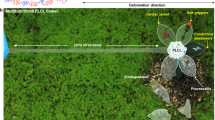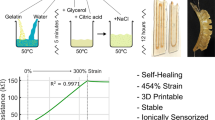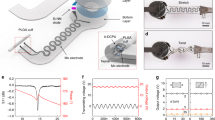Abstract
Implantable sensors can be used to monitor biomechanical strain continuously. However, three key challenges need to be addressed before they can be of use in clinical practice: the structural mismatch between the sensors and tissue or organs should be eliminated; a practical suturing attachment process should be developed; and the sensors should be equipped with wireless readout. Here, we report a wireless and suturable fibre strain-sensing system created by combining a capacitive fibre strain sensor with an inductive coil for wireless readout. The sensor is composed of two stretchable conductive fibres organized in a double helical structure with an empty core, and has a sensitivity of around 12. Mathematical analysis and simulation of the sensor can effectively predict its capacitive response and can be used to modulate performance according to the intended application. To illustrate the capabilities of the system, we use it to perform strain measurements on the Achilles tendon and knee ligament in an ex vivo and in vivo porcine leg.
This is a preview of subscription content, access via your institution
Access options
Access Nature and 54 other Nature Portfolio journals
Get Nature+, our best-value online-access subscription
$29.99 / 30 days
cancel any time
Subscribe to this journal
Receive 12 digital issues and online access to articles
$119.00 per year
only $9.92 per issue
Buy this article
- Purchase on Springer Link
- Instant access to full article PDF
Prices may be subject to local taxes which are calculated during checkout





Similar content being viewed by others
Data availability
The raw data generated in this study are freely available from the corresponding authors on reasonable request.
Code availability
The custom code developed for recording data from the network analyser is available on Github at https://github.com/jaelee2020/suturable_fibre_strain_sensors.git.
References
Rogers, J., Malliaras, G. & Someya, T. Biomedical devices go wild. Sci. Adv. 4, eaav1889 (2018).
Yang, G., Rothrauff, B. B. & Tuan, R. S. Tendon and ligament regeneration and repair: clinical relevance and developmental paradigm. Birth Defects Res. C 99, 203–222 (2013).
Boutry, C. M. et al. A stretchable and biodegradable strain and pressure sensor for orthopaedic application. Nat. Electron. 1, 314–321 (2018).
Kubo, K., Kanehisa, H., Kawakami, Y. & Fukunaga, T. Influence of static stretching on viscoelastic properties of human tendon structures in vivo. J. Appl. Physiol. 90, 520–527 (2001).
Bogaerts, S., Desmet, H., Slagmolen, P. & Peers, K. Strain mapping in the Achilles tendon—a systematic review. J. Biomech. 49, 1411–1419 (2016).
Waugh, C. M., Blazevich, A. J., Fath, F. & Korff, T. Age-related changes in mechanical properties of the Achilles tendon. J. Anat. 220, 144–155 (2012).
Cone, S. G. et al. Orientation changes in the cruciate ligaments of the knee during skeletal growth: a porcine model. J. Orthop. Res. 35, 2725–2732 (2017).
McGilvray, K. C. et al. Implantable microelectromechanical sensors for diagnostic monitoring and post-surgical prediction of bone fracture healing. J. Orthop. Res. 33, 1439–1446 (2015).
Roriz, P., Carvalho, L., Frazão, O., Santos, J. L. & Simões, J. A. From conventional sensors to fibre optic sensors for strain and force measurements in biomechanics applications: a review. J. Biomech. 47, 1251–1261 (2014).
Hein, C., Wilton, P. & Wongworawat, M. D. Review of flexor tendon rehabilitation protocols following zone II repair. Crit. Rev. Phys. Rehabil. Med. 27, 11–18 (2015).
Saini, N., Kundnani, V., Patni, P. & Gupta, S. Outcome of early active mobilization after flexor tendons repair in zones II-V in hand. Indian J. Orthop. 44, 314–321 (2010).
Abdul Razak, A. H. et al. Foot plantar pressure measurement system: a review. Sensors 12, 9884–9912 (2012).
Yeadon, M. R. & Challis, J. H. The future of performance‐related sports biomechanics research. J. Sports Sci. 12, 3–32 (1994).
Tybrandt, K. et al. High-density stretchable electrode grids for chronic neural recording. Adv. Mater. 1706520, 1706520 (2018).
Park, J. et al. Electromechanical cardioplasty using a wrapped elasto-conductive epicardial mesh. Sci. Transl. Med. 8, 344ra86 (2016).
Kang, S.-K. et al. Bioresorbable silicon electronic sensors for the brain. Nature 530, 71–76 (2016).
Khodagholy, D. et al. Organic electronics for high-resolution electrocorticography of the human brain. Sci. Adv. 2, e1601027 (2016).
Rivas, L. et al. Micro-needle implantable electrochemical oxygen sensor: ex-vivo and in-vivo studies. Biosens. Bioelectron. 153, 112028 (2020).
Dautta, M., Alshetaiwi, M., Escobar, J. & Tseng, P. Passive and wireless, implantable glucose sensing with phenylboronic acid hydrogel-interlayer RF resonators. Biosens. Bioelectron. 151, 112004 (2020).
Zhou, J. et al. Top-down strategy of implantable biosensor using adaptable, porous hollow fibrous membrane. ACS Sens. 4, 931–937 (2019).
Bai, W. et al. Bioresorbable photonic devices for the spectroscopic characterization of physiological status and neural activity. Nat. Biomed. Eng. 3, 644–654 (2019).
Stauffer, F. et al. Soft electronic strain sensor with chipless wireless readout: toward real-time monitoring of bladder volume. Adv. Mater. Technol. 3, 1800031 (2018).
Boutry, C. M. et al. Biodegradable and flexible arterial-pulse sensor for the wireless monitoring of blood flow. Nat. Biomed. Eng. 3, 47–57 (2019).
Ma, Y. et al. Relation between blood pressure and pulse wave velocity for human arteries. Proc. Natl Acad. Sci. USA 115, 11144–11149 (2018).
Kim, Y. J. et al. Protective effects of APOE e2 against disease progression in subcortical vascular mild cognitive impairment patients: a three-year longitudinal study. Sci. Rep. 7, 1910 (2017).
Park, J. et al. Printing of wirelessly rechargeable solid-state supercapacitors for soft, smart contact lenses with continuous operations. Sci. Adv. 5, eaay0764 (2019).
Lee, J. et al. Flexible, sticky, and biodegradable wireless device for drug delivery to brain tumors. Nat. Commun. 10, 5205 (2019).
Lee, B. et al. Soft, skin-interfaced microfluidic systems with wireless, battery-free electronics for digital, real-time tracking of sweat loss and electrolyte composition. Small 14, 1802876 (2018).
Colville, M. R., Marder, R. A., Boyle, J. J. & Zarins, B. Strain measurement in lateral ankle ligaments. Am. J. Sports Med. 18, 196–200 (1990).
Race, A. & Amis, A. A. The mechanical properties of the two bundles of the human posterior cruciate ligament. J. Biomech. 27, 13–24 (1994).
Frutiger, A. et al. Capacitive soft strain sensors via multicore-shell fiber printing. Adv. Mater. 27, 2440–2446 (2015).
Cooper, C. B. et al. Stretchable capacitive sensors of torsion, strain, and touch using double helix liquid metal fibers. Adv. Funct. Mater. 27, 1605630 (2017).
Yu, L. et al. Dual-core capacitive microfiber sensor for smart textile applications. ACS Appl. Mater. Interfaces 11, 33347–33355 (2019).
Li, J. et al. Highly conductive PVA/Ag coating by aqueous in situ reduction and its stretchable structure for strain sensor. ACS Appl. Mater. Interfaces 12, 1427–1435 (2020).
Pan, Z. et al. All-in-one stretchable coaxial-fiber strain sensor integrated with high-performing supercapacitor. Energy Storage Mater. 25, 124–130 (2020).
Qu, Y. et al. Superelastic multimaterial electronic and photonic fibers and devices via thermal drawing. Adv. Mater. 30, 1707251 (2018).
Xi, W., Yeo, J. C., Yu, L., Zhang, S. & Lim, C. T. Ultrathin and wearable microtubular epidermal sensor for real-time physiological pulse monitoring. Adv. Mater. Technol. 2, 1700016 (2017).
Xi, W. et al. Soft tubular microfluidics for 2D and 3D applications. Proc. Natl Acad. Sci. USA 114, 10590–10595 (2017).
Yu, L. et al. Highly stretchable, weavable, and washable piezoresistive microfiber sensors. ACS Appl. Mater. Interfaces 10, 12773–12780 (2018).
Lee, J. et al. Highly sensitive multifilament fiber strain sensors with ultrabroad sensing range for textile electronics. ACS Nano 12, 4259–4268 (2018).
Lion, A. A constitutive model for carbon black filled rubber: experimental investigations and mathematical representation. Contin. Mech. Thermodyn. 8, 153–169 (1996).
Bergström, J. S. & Boyce, M. C. Constitutive modeling of the large strain time-dependent behavior of elastomers. J. Mech. Phys. Solids 46, 931–954 (1998).
Jin, L. et al. Microstructural origin of resistance-strain hysteresis in carbon nanotube thin film conductors. Proc. Natl Acad. Sci. USA 115, 1986–1991 (2018).
Sim, K. et al. Fully rubbery integrated electronics from high effective mobility intrinsically stretchable semiconductors. Sci. Adv. 5, eaav5749 (2019).
Farris, D. J., Trewartha, G. & Polly McGuigan, M. Could intra-tendinous hyperthermia during running explain chronic injury of the human Achilles tendon? J. Biomech. 44, 822–826 (2011).
Lai, A., Schache, A. G., Lin, Y. C. & Pandy, M. G. Tendon elastic strain energy in the human ankle plantar-flexors and its role with increased running speed. J. Exp. Biol. 217, 3159–3168 (2014).
Vörös, J. et al. Implantable analogue device and system comprising such device. European patent EP16172056.0 (2017).
Lee, S. et al. Ag nanowire reinforced highly stretchable conductive fibers for wearable electronics. Adv. Funct. Mater. 25, 3114–3121 (2015).
Lee, J. et al. Conductive fiber-based ultrasensitive textile pressure sensor for wearable electronics. Adv. Mater. 27, 2433–2439 (2015).
Acknowledgements
We thank T. Schlotter for his support with the numerical simulations. In addition, we thank T. Lee and K. Yoon of Yonsei University in South Korea for their help with the conductive fibres. This work was supported by the ETH Zurich Postdoctoral Fellowship Program, co-founded by the Marie Curie Actions for People COFUND Program, by ETH Zurich and SENESCYT and by the KRIBB (Korea Research Institute of Bioscience and Biotechnology) Research Initiative Program (KGM4252021), Korea. The work was also financed by the DGIST Start-up Fund Program of the Ministry of Science and ICT (2021010030), and the Korea Medical Device Development Fund grant, funded by the Korea government (the Ministry of Science and ICT) (project number 2020M3E5D8107020).
Author information
Authors and Affiliations
Contributions
J.L. designed the overall concept and experiments, and performed all the tasks including the fabrication, measurements, data analysis and mathematical analysis. S.J.I. contributed to building the Python code for wireless measurement in the ex vivo experiment. G.S.P. conducted the finite element method simulation on the working mechanism of the fibre sensor. H.K., J.Y., C.-Y.J., H.-C.S. and K.-I.J. contributed to the in vivo experiments. C.J. and H.C. conducted the cell viability tests for demonstrating the biocompatibility of the system. D.E. and F.S. provided the professional suturing technique for the ex vivo experiment. B.L.Z. and A.F.R. contributed to the measurement experiments and data analysis. C.F. contributed to the analytical model of the sensor. R.K. performed the wireless measurement of the sensing system. J.V. contributed to the development of the sensor concept, data interpretation, mathematical analysis and critical revisions of the article.
Corresponding authors
Ethics declarations
Competing interests
The authors declare no competing interests.
Additional information
Peer review information Nature Electronics thanks Roozbeh Ghaffari, John Ho, Chwee Lim and the other, anonymous, reviewer(s) for their contribution to the peer review of this work.
Publisher’s note Springer Nature remains neutral with regard to jurisdictional claims in published maps and institutional affiliations.
Supplementary information
Supplementary Information
Supplementary Figs. 1–28 and six notes.
Supplementary Video 1
Behaviour of a double helical fibre strain sensor under tensile strain.
Supplementary Video 2
Suturing a fibre strain-sensing system on the Achilles tendon of a porcine leg.
Supplementary Video 3
Ex vivo demonstration of a fibre strain-sensing system.
Supplementary Video 4
In vivo demonstration of a fibre strain-sensing system.
Supplementary Video 5
X-ray video of an implanted fibre strain-sensing system during movements.
Rights and permissions
About this article
Cite this article
Lee, J., Ihle, S.J., Pellegrino, G.S. et al. Stretchable and suturable fibre sensors for wireless monitoring of connective tissue strain. Nat Electron 4, 291–301 (2021). https://doi.org/10.1038/s41928-021-00557-1
Received:
Accepted:
Published:
Issue Date:
DOI: https://doi.org/10.1038/s41928-021-00557-1
This article is cited by
-
Ultra-sensitive, highly linear, and hysteresis-free strain sensors enabled by gradient stiffness sliding strategy
npj Flexible Electronics (2024)
-
Highly Elastic, Bioresorbable Polymeric Materials for Stretchable, Transient Electronic Systems
Nano-Micro Letters (2024)
-
Advances in Wireless, Batteryless, Implantable Electronics for Real-Time, Continuous Physiological Monitoring
Nano-Micro Letters (2024)
-
pH- and near-infrared light-responsive, biomimetic hydrogels from aqueous dispersions of carbon nanotubes
Nano Research (2024)
-
Stretchable and self-healing conductive fibers from hierarchical silver nanowires-assembled network
Nano Research (2024)



